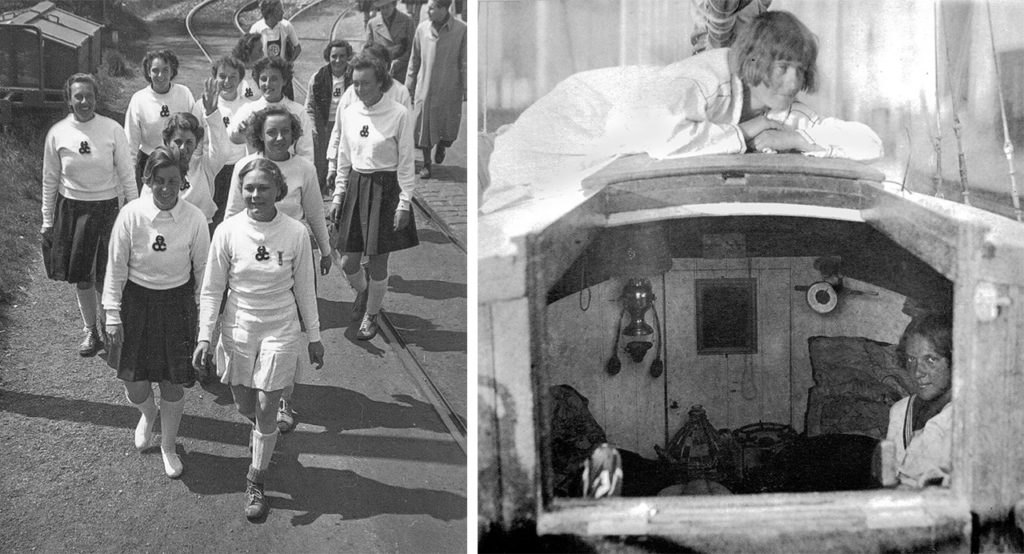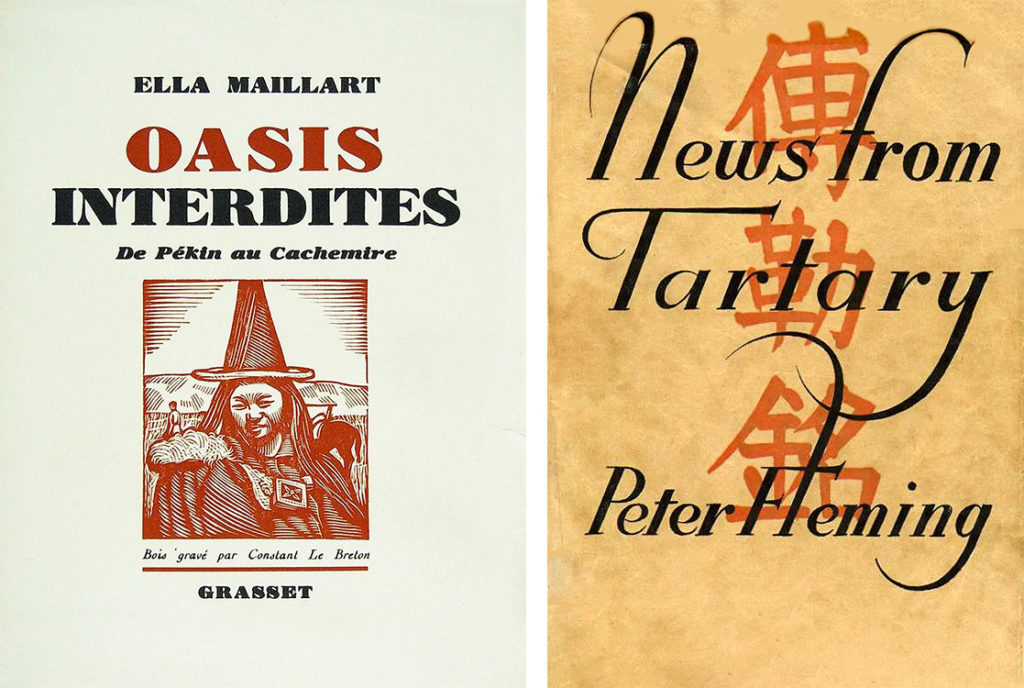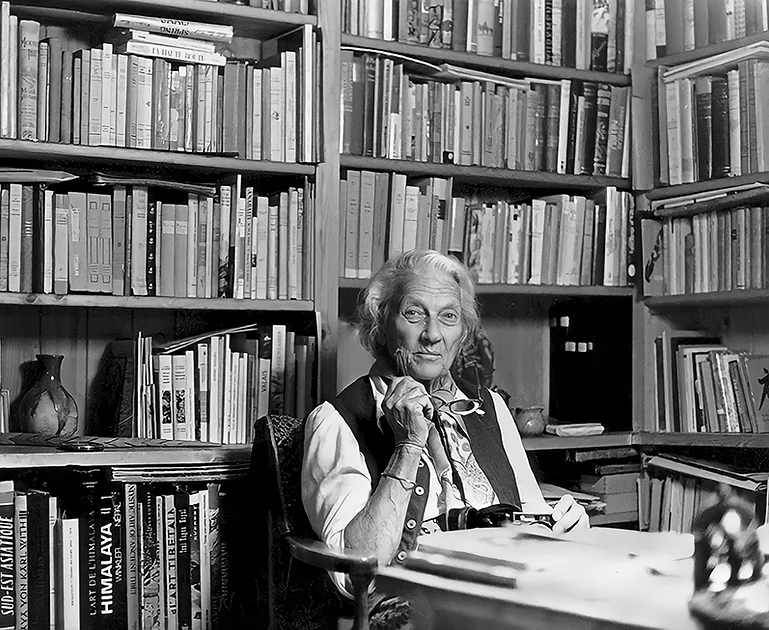Determined aviatrix, top-level sportswoman, daring traveller, talented photographer, journalist by necessity and passionate guide, Ella Maillart had many lives. Born in 1903 and gone in 1997, she lived through almost a century, a tormented century that she documented in her notes, books, photographs and films.
“Where there is a will there is a way” reads the inscription on the commemorative plaque on Avenue Gaspard-Vallette, Ella Maillart’s Geneva address. This 17th-century proverb is ultimately a nine-word biography of the 93 heady years of this world explorer, who gave herself the means to achieve each of her multiple goals. Olympic regattas, world ski championships, literary prizes, explorations beyond authorized frontiers, the quest for self…
But let’s start with the beginnings of a life of independence.
Determination and dreams of adventure
Ella Maillart was born into a well-to-do Geneva family. Her father Paul Maillart, a fur trader, was interested in world affairs, while her mother Marie Dagmar, of Danish origin, followed a sports-oriented upbringing. In those days, skiing every Sunday was considered an “English eccentricity”! Nonetheless, this family climate nurtured an athletic rigor and intelligent curiosity in little Ella, which she was to nurture throughout her life. Although school bored her to the point of failing her final exams, she was determined and proactive. Case in point? She founded the first women’s land field hockey club in French-speaking Switzerland when she was just sixteen, and learned to navigate the lake by trial and error. When the Maillart family moved to Le Creux-de-Genthod, Ella met a neighbor her own age, Hermine de Saussure. It was this meeting with the girl nicknamed Miette that gave the future explorer her first direction in life. In the 1910s, the two girls tried their hand at sailing on Miette’s father’s boat. Completely self-taught, apart from the occasional request for advice from nearby sailors, they began by sailing in the small port of Genthod, gradually extending the distance to explore Lake Geneva. The further they sail from Geneva’s shores, the more they thirst for adventure on wider horizons. The Mediterranean beckons…
« This city life didn’t allow me to have the outdoor life I dreamed of. » Ella Maillart in an RTS interview.

Call of the sea
They first tamed the turquoise waters aboard Perlette in 1922. Incidentally, as they didn’t know how to run an engine, they swapped it for a sack of potatoes, a much safer bet for the two self-taught sailors who were about to set sail for Corsica! And it wasn’t long before their first big voyage. In 1925, they decided to sail from Marseille to Athens with other young girls aboard an old sailing ship: the Bonita. A young, feminine crew that aroused much astonishment, even mockery, from the boats they passed. But in spite of the naysayers, the expedition was so successful that they decided to set course for the Atlantic Ocean! What ambition and daring! It was at this very moment that Ella Maillart bought her first camera to document their journey. A turning point in her life? But the tiller of success turns. Without even reaching the ocean, Miette fell ill and had to return to Switzerland. Although Ella Maillart continued her journey, she eventually stopped in Brittany..
« Sailing since I was very young had given me ideas of emancipation and world conquest. I felt that the whole planet belonged to me, so why not discover it? » Ella Maillart in an RTS interview.
Returning to Switzerland, a period of doubt and stagnation begins for Ella Maillart. Miette, married and pregnant, could no longer venture into the bubbling eux. Could this also be a direction for Ella’s future?” I didn’t have the courage to get married”, she would later say. Not knowing which path to take, she searches for herself.
Without much conviction, she sailed for a while with the British and tried her hand at various jobs on dry land, as a typist, actress, understudy and sportswoman. She steered in the 1924 Olympic regattas and took part in four world ski championships, but despite these achievements, which many would describe as the feats of a lifetime, she didn’t fit in. L’arrêt de Miette thus closes the chapter of Ella Maillart’s dreams of the sea. But the next one is about to open. Without giving too much away, all these sailing stories will be recounted in La vagabonde des mers (1942).

New land routes to the east
Although she no longer had a course, Ella Maillart decided to continue her journey on land. Chance encounters and a combination of circumstances gave her a new direction. First there were the discussions with Russian émigrés in Berlin, who spoke to her of Soviet youth and culture. Then there was the financial help from Jack London’s widow to pay for a trip to Moscow. Then there was accommodation in the capital of the USSR with Olga Tolstoy, the famous writer’s daughter-in-law, and exchanges with the film-maker Vsevolod Poudovkine. Finally, he was introduced to the publisher Charles Fasquelle, who finally published his first book, Parmi la jeunesse russe – De Moscou au Caucase. From then on, the credo of her new life would be to write and produce reports to finance her next trip. She became a reporter out of necessity, to satisfy her desire to discover the beauty of the world and the sensitivity of its people. And this first trip to the East set Ella Maillart on the long road to the Orient, with the names of exotic countries to follow over the years.
« The pretext of the reports was a kind of alibi: I was doing it until I knew better. Until what? I didn’t know, but I wasn’t satisfied with myself or the others. » Ella Maillart in an RTS interview.
Landscapes on film
The year 1934 undoubtedly marks her most dangerous and extraordinary, physically enduring and psychologically thorny, journey. Sent as a reporter for Le Petit Parisien to Manchuria, Ella Maillart decided to cross Central Asia to visit one of the world’s most secretive regions, Chinese Turkestan. Accompanying her on this thrilling and dangerous adventure is Times journalist Peter Fleming. If that name rings a bell, no wonder: he’s the brother of Ian Fleming, writer of the famous spy 007! While the duo had authorization for the first part of their journey, the rest of the journey involved taking impossible routes and avoiding border crossings. After seven complex but fortunately politically trouble-free months, the grail of Kashmir is reached. What we wouldn’t do for a scoop for the French and British press!
« They make the same journey, but experience it very differently. It’s interesting to read the book Ella Maillart wrote on her return from the Forbidden Oases, and the book Peter Fleming published on his return, News from Tartary, which went on to become a bestseller. Ella Maillart’s book is a documentary, a reportage, while Peter Fleming’s book is a novel, a film. » Daniel Girardin, former curator of the Musée de l’Élysée.

Le voyage spirituel
Ella Maillart continues to discover the world, collect ethnological evidence, write for Le Petit Parisien, tell her stories in books, immortalize life with her Leica and, finally, document a world in transition and upheaval. While on a road trip to help her novelist friend Annemarie Schwarzenbach quit drugs, the Second World War broke out. Europe is torn apart and destroyed. Unable to continue or return, Ella Maillart takes refuge in India. Thus began her new quest: the search for meaning and self beyond her own borders. In this new introspective journey, which would ultimately last five years, she was accompanied by two wise men. And, as usual, she produced a book: Ti-Puss ou l’Inde avec ma chatte in 1952, which would enable her to finance her next trip. But which one? The return one?
Heading for the top
Ella Maillart returned to Switzerland at the end of the war and built her first home: a chalet in Chandolin in the Val d’Anniviers. Although the peaceful life of a small Swiss village was pleasant, the spirit of adventure took over! And so she set off again and again, accompanying groups of tourists across the Asian continent. The explorer thus spent the rest of her life between her two passions, skiing and travelling, before passing away in 1997 in her adopted Valais, leaving behind her the story of a century, of a life.

To pay tribute to Ella Maillart, Chandolin has opened the Espace Ella Maillart, entirely dedicated to the career of this witness to her time. Permanent exhibitions are also held regularly to present the explorer’s great journeys and her vision of the world. The next one will run from December 7, 2023 to April 21, 2024 at the MAH. The central part of the Musée Rath will be occupied by silent witnesses to Ella Maillart’s many journeys, such as photographic archives, texts and documents. The two lateral spaces, meanwhile, will be dedicated to two travelling artists, Anne-Julie Raccoursier and Pauline Julie.
